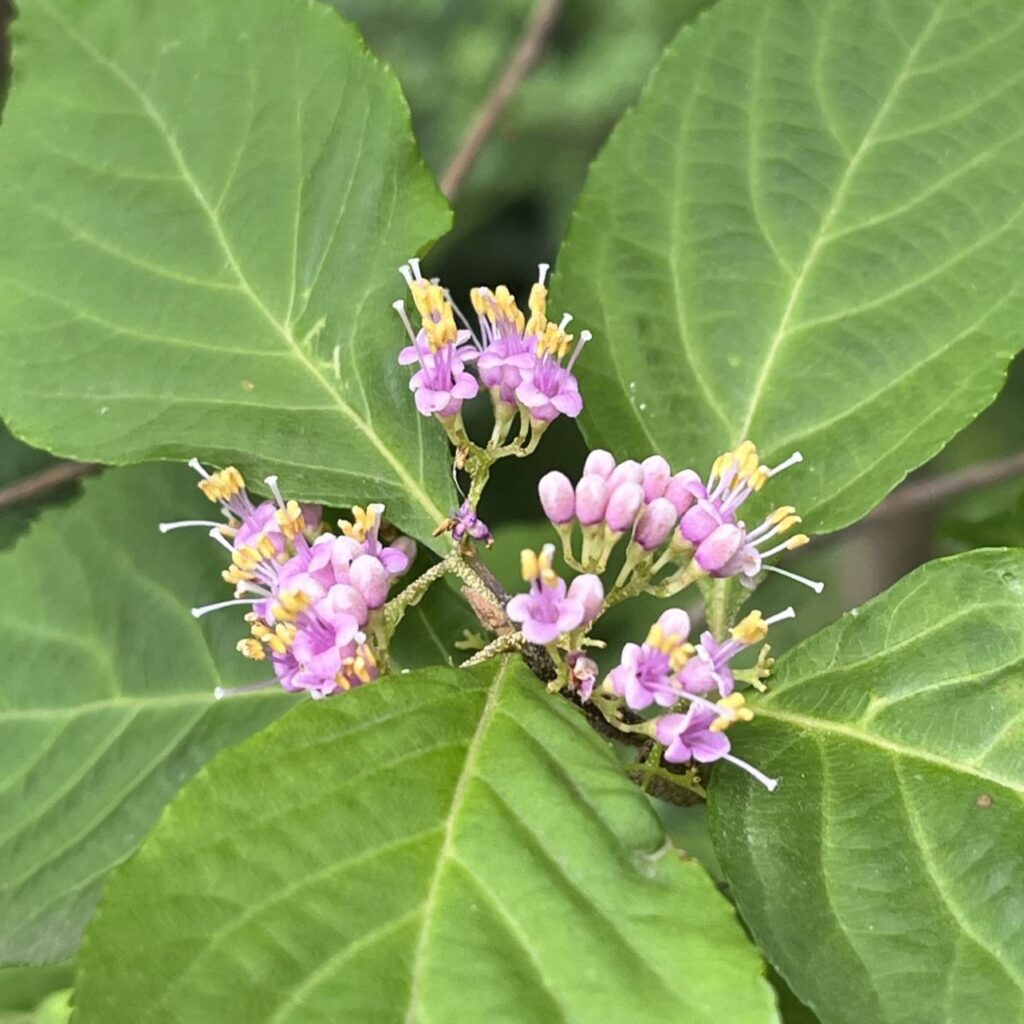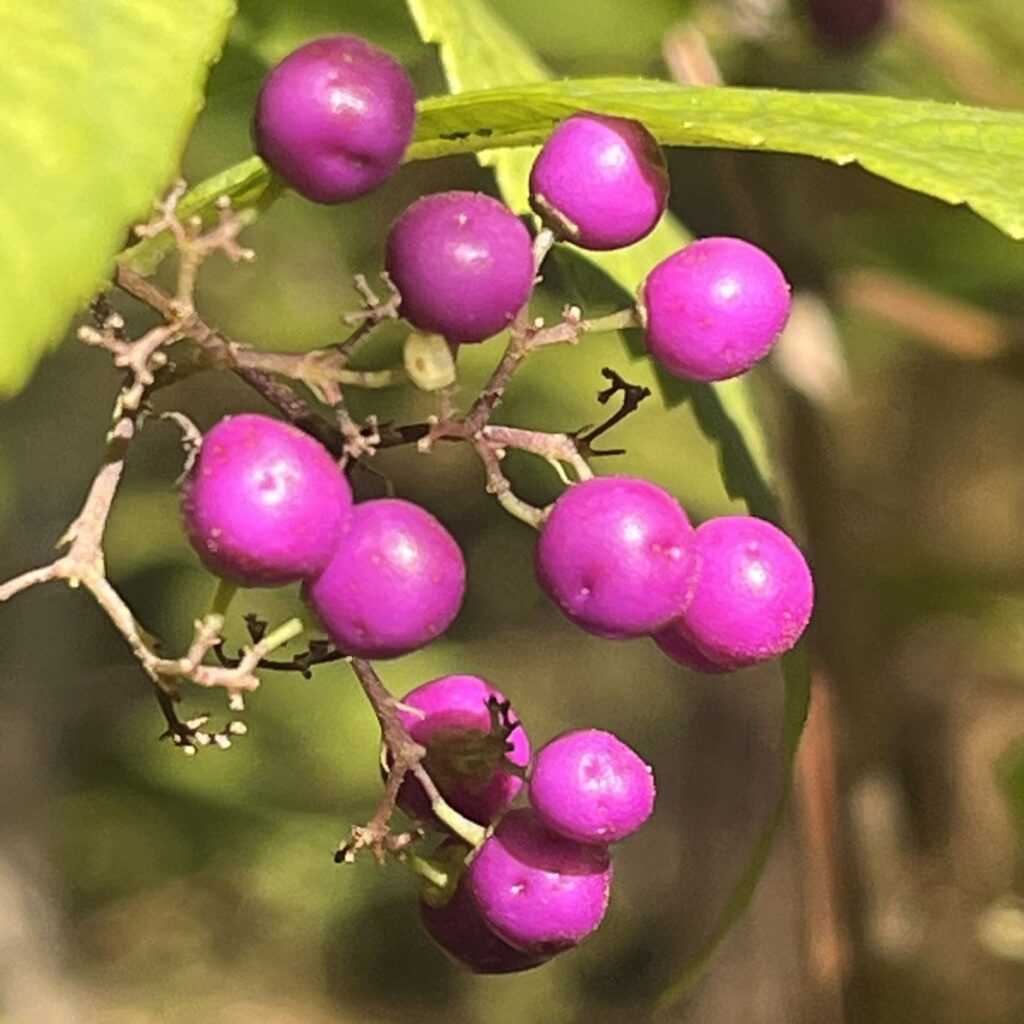ムラサキシキブの和名は、世界最古の長編恋愛小説『源氏物語』の作者の名前。可愛らしい桃色の花が咲き、艶やかな赤紫色の実が熟します。
The Japanese name of Japanese Beautyberry is the name of the author of “The Tale of Genji”, the world’s oldest full-length romance novel. It blooms with pretty pink flowers and ripens with glossy purple fruits.
【仮名】ムラサキシキブ
【和名】紫式部
【英名】Japanese Beautyberry
【学名】Callicarpa japonica
【誕生】10/ 17, 11/ 04, 11/ 06, 11/ 12
【開花】06, 07, 08月
【花色】Pink, Purple
ムラサキシキブ
ムラサキシキブの概要

ムラサキシキブはシソ科の落葉低木。日本では北海道南西部、本州、四国、九州、南西諸島、国外では朝鮮半島、中国、台湾で自生しています。和名は11世紀に著された世界最古の長編恋愛小説『源氏物語』の作者の名前。可愛らしい桃色の花が咲き、艶やかな赤紫色の実が熟します。
ムラサキシキブの名前

ムラサキシキブは平安時代の作家、歌人でもある女官の名前。紫色の実が密に着くので「紫重実」「紫敷き実」と呼ばれていましたが、読みが似ている著名な女性の名前に転じました。英名は「日本の美しい実」という意味。ラテン語の属名カリカルパも「美しい実」という意味です。
ムラサキシキブの姿形

ムラサキシキブの幹は直立。樹皮が灰褐色で、太くなると縦に裂け目が入ります。葉は薄く、先の尖った楕円形で縁に鋸歯があり、対生。花は桃色の小花が集まって咲き、かすかに香ります。小花は花被が4裂、雄しべが4本、雌しべが2裂。花後の果実は球形で、赤紫色に熟します。
ムラサキシキブの近縁

ムラサキシキブの近縁種「小紫」は名前が「小さな紫式部」という意味。「小式部」という別名もあり、姿形がよく似ています。紫式部との違いは、丈が低く、枝が垂れ、葉が小さく、果実が小さいこと。葉の先半分だけに鋸歯があり、葉柄と花柄が離れ、果実が揃って密に着きます。
Japanese Beautyberry

Japanese Beautyberry is a deciduous shrub of the Lamiaceae family. In Japan, it grows wild in southwestern Hokkaido, Honshu, Shikoku, Kyushu, and the Ryukyu Islands, and overseas in the Korean Peninsula, China, and Taiwan. The Japanese name is the name of the author of “The Tale of Genji”, the world’s oldest full-length romance novel, written in the 11th century. It blooms with pretty pink flowers and ripens with glossy purple fruits.
Japanese Beautyberry is the name of a court lady who was a writer and poet in the Heian period. The English name means “beautiful fruit of Japan”. The Latin genus name Callicarpa also means “beautiful fruit”.
The trunk of Japanese Beautyberry is upright. The bark is gray-brown, and when it becomes thicker, it has vertical cracks. The leaves are thin, oval, pointed, and have sawtoothed edges, and grow in opposite pairs. Small pink flowers bloom in clusters, giving off a faint fragrance. The small flowers have four-lobed perianths, four stamens, and two-lobed pistils. The fruits that bloom after flowering are spherical and ripen purple.
Callicarpa dichotoma, a species closely related to Japanese Beautyberry, has a Japanese name meaning “Small Japanese Beautyberry” and looks very similar to Japanese Beautyberry. The difference between Small Japanese Beautyberry and Japanese Beautyberry is that it is shorter, has drooping branches, smaller leaves, and smaller fruits. In addition, only the tip half of the leaves has sawtooth, the petiole and pedicel are separated, and the fruits grow close together.



